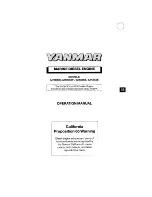
3
Never allow an open flame or electric sparks near
the batteries. Never smoke in proximity to the
batteries. The batteries give off hydrogen gas
during charging which when mixed with air can
form an explosive gas -oxyhydrogen. This gas is
easily ignited and highly volatile. Incorrect con-
nection of the battery can cause a single spark
which is sufficient to cause an explosion with
resulting damage. Do not shift the connections
when attempting to start the engine (spark risk)
and do not lean over any of the batteries. Refer to
instructions in the Instruction Book.
Always ensure that the Plus (positive) and Minus
(negative) battery leads are correctly installed on
the corresponding terminal posts on the batteries.
Incorrect installation can result in serious damage
to the electrical equipment. Refer to the wiring
diagrams.
Always use protective goggles when charging and
handling the batteries. Battery electrolyte contains
sulfuric acid which is highly corrosive. Should the
battery electrolyte come into contact with unpro-
tected skin wash off immediately using plenty of
water and soap. If battery acid comes in contact
with the eyes, immediately flush with plenty of
water and obtain medical assistance without
delay.
Turn the engine off and turn off the power at the
main switches (breakers) before carrying out work
on the electrical system.
Clutch adjustments, where a clutch is fitted, must
be carried out with the engine turned off.
Use the lifting eyes fitted on the engine/reverse
gear when lifting the drive unit. Always check that
the lifting equipment used is in good condition and
has the load capacity to lift the engine (engine
weight including reverse gear and any extra
equipment installed).
Use a lifting beam to raise the engine to ensure
safe handling and to avoid damaging engine parts
installed on the top of the engine.
All chains and cables should run parallel to each
other and as perpendicular as possible against
the side of the engine.
If extra equipment is installed on the engine which
alters its center of gravity a special lifting device is
required to obtain the correct balance for safe
handling.
Never carry out work on an engine suspended on
a hoist.
WARNING! The components in the electrical
system and in the fuel system on Volvo Penta
products are designed and manufactured to
minimize risks of fire and explosion.
The engine must not be run in areas where there
are explosive materials.
Fuel filter replacement should be carried out on a
cold engine in order to avoid the risk of fire
caused by fuel spillage on the exhaust manifold.
Always cover the generator (alternator), if it is
located under the fuel filter. The generator
(alternator) can be damaged by spilled fuel.
WARNING! The delivery pipes must not be bent,
twisted or subjected to other stress. Replace
damaged delivery pipes.
Always use protective gloves when detecting
leaks. Liquids ejected under pressure can pene-
trate the body tissues and cause serious injury.
Danger of blood poisoning.
Always use fuels recommended by Volvo Penta.
Refer to the Instruction manual. Use of fuels that
are of a lower quality can damage the engine. On
a diesel engine poor quality fuel can cause the
actuating rod to seize and the engine to overrev
with resulting risk of damage to the engine and
personal injury. Poor fuel quality can also lead to
higher maintenance costs.
Observe the following when cleaning with high-
pressure water jets. Never point the water jet at
seals, rubber hoses or electrical components.
Never use high pressure jets when washing the
engine.
Summary of Contents for TAMD162C
Page 1: ...INSTRUCTIONBOOK TAMD162C TAMD163A TAMD163P ...
Page 2: ......
Page 82: ...80 Notes ...
Page 83: ......
Page 84: ...7737387 6 English 8 1998 ...






































